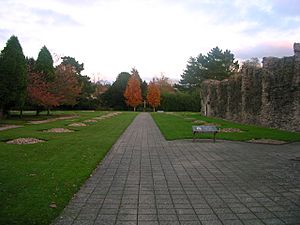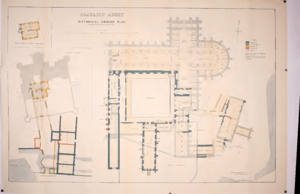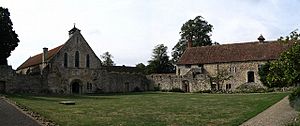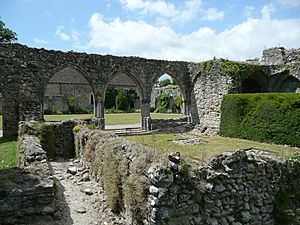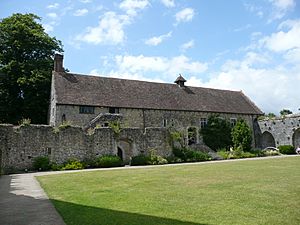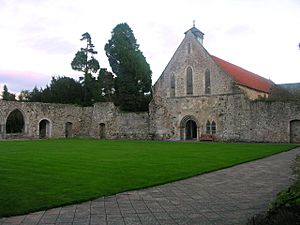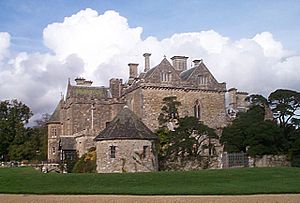Beaulieu Abbey facts for kids

The cloister and refectory of Beaulieu Abbey seen from the west range
|
|
| Monastery information | |
|---|---|
| Full name | The Abbey Church of St Mary, Bellus Locus Regis (Latin: "The beautiful place of the king") |
| Other names | Beaulieu Abbey |
| Order | Cistercian |
| Established | 1203/1204 |
| Disestablished | 1538 |
| Mother house | Cîteaux Abbey, France |
| Dedicated to | Virgin Mary |
| Diocese | Winchester |
| Controlled churches | Shilton, Inglesham, Coxwell, St Keverne |
| People | |
| Founder(s) | King John |
| Important associated figures | King John, Thomas Wriothesley, 1st Earl of Southampton, Abbot Thomas Stevens |
| Site | |
| Location | Beaulieu, Hampshire, England |
| Visible remains | cloister, refectory (now the parish church) and west range, gatehouse, foundations of the church, many other ruins, earthworks |
| Public access | yes |
Beaulieu Abbey was a special Cistercian abbey (a type of monastery) in Hampshire, England. It was started in 1203 or 1204 by King John. Thirty monks from Cîteaux Abbey in France came to live here. This was the main home of the Cistercian order.
The abbey's old Medieval Latin name was Bellus Locus Regis. This means "The beautiful place of the king." Sometimes people also called it Bewley or Beaulie long ago.
Contents
Beaulieu Abbey: A Royal History
How Beaulieu Abbey Started
The first leader of Beaulieu Abbey was Abbot Hugh. King John liked him a lot and sent him on important trips. Hugh later became a Bishop.
King John gave the new abbey many gifts. These included lands across southern England and in the New Forest. He also gave them corn, money, building materials, and 120 cows. A golden cup and a barrel of wine each year were also part of the gifts.
King Henry III, John's son, was also very kind to Beaulieu. Because of this, the abbey became quite rich. However, it was not the wealthiest Cistercian abbey in England.
Monks from Beaulieu Abbey helped start four other abbeys. These were Netley Abbey (1239), Hailes Abbey (1246), Newenham Abbey (1247), and St Mary Graces Abbey (1350).
Amazing Abbey Buildings
The buildings at Beaulieu Abbey were very grand. They showed how important this royal abbey was. The main church was huge and shaped like a cross. It was built in an early Gothic style. French churches, like Cîteaux and Clairvaux, greatly influenced its design.
The church was 102 meters (about 335 feet) long. It had a rounded end with 11 small chapels. It took over 40 years to build. The church was officially opened in 1246. King Henry III and his queen were there, along with many other important people.
South of the church was a cloister (an open courtyard). Around this courtyard were other important rooms. These included the chapter house, refectory (dining hall), kitchens, and living areas for the monks. There was also a separate hospital area for sick monks. Workshops, farm buildings, and guest houses surrounded the abbey. There was also a mill, gardens, and fishponds. Strong gatehouses and a wall protected the abbey. A special water gate allowed boats to come in from the river.
A Safe Place: Sanctuary Rights
Pope Innocent III made Beaulieu an "exempt abbey." This meant the abbot only answered to the Pope, not to any local bishop. The Pope also gave Beaulieu special sanctuary rights. These rights were much stronger than usual. They covered not just the abbey buildings but also the entire 23.5-hectare (about 58-acre) area around it.
Because Beaulieu was the only abbey in its area with such strong sanctuary rights, it became a safe place. People who were in trouble, like those in debt or even criminals, could find refuge there. Political enemies of the government also came here. For example, Anne Neville, wife of "Warwick the Kingmaker," sought safety here in 1471. Later, Perkin Warbeck fled to Beaulieu from King Henry VII's army.
When the Abbey Closed Down
In 1535, King Henry VIII ordered a survey of all church money. This was before he took over the monasteries. Beaulieu Abbey's income was about £428. This meant it was not immediately closed down by the first law.
The last abbot of Beaulieu was Abbot Thomas Stevens. He became abbot in 1536. He had been the abbot of Netley Abbey, which had already closed. Beaulieu Abbey finally had to close in April 1538. This was part of the Dissolution of the Monasteries.
Many monks received money each year to live on. Abbot Thomas received a large sum. He later became a treasurer at Salisbury Cathedral and passed away in 1550.
When the abbey closed, there were 32 people living in the abbey grounds. They were seeking sanctuary for various reasons, including debt or crimes. They lived there with their families. The government decided to let the people in debt stay in their homes. Some criminals also received pardons.
From Abbey to Palace House
After Beaulieu Abbey closed, many people wanted to own its valuable lands. Eventually, Thomas Wriothesley, 1st Earl of Southampton, received the abbey and its lands from King Henry.
Wriothesley quickly started building a new house. He tore down the church, which was common. But instead of turning the cloister buildings into his home, he used the large gatehouse. This gatehouse became the main part of what is now Beaulieu Palace House.
Lord Southampton saved the monks' dining hall (refectory). He gave it to the people of Beaulieu village to be their church. It is still the parish church today. The west side of the abbey, called the Domus, was also saved. The rest of the abbey was left to become ruins.
What You Can See Today
Even though much was destroyed, there is still a lot to see at Beaulieu Abbey. You can see the outline of the huge 102-meter-long church on the grass. A cross and trees mark where the altar once stood. Part of the church's south wall still stands.
The cloister courtyard is now an open space with fragrant herbs. To the east, you can see the remains of the sacristy, the chapter house, and the monks' day room. The front of the chapter house, with its three Gothic arches, is still visible.
The monks' dining hall (refectory) is now the village church. It is a beautiful 13th-century building. It has tall, narrow windows and a special pulpit where someone would read during meals.
The west range, called the Domus, was once for the lay brothers (monks who did manual labor). It now has a museum about monastic life. You can see embroidered wall hangings showing scenes from the abbey's history.
The abbey was surrounded by two walled courtyards. Much of these walls still stand. The smaller outer gatehouse is still used. The inner gatehouse was changed into Beaulieu Palace House. The descendants of Thomas Wriothesley still live there today.
Beaulieu Abbey is open to visitors as part of the "Beaulieu" attraction. This includes:
- Beaulieu Abbey
- National Motor Museum
- Beaulieu Palace House
- Secret Army Exhibition (about training during World War II)
- Gardens
- A monorail
- Rides
The Domus building is often used for events and dining.
Fun Facts and Legends
The King's Dream
Beaulieu Abbey was the only religious place King John started. A legend says that King John was angry with the Cistercian monks. He supposedly made them be trampled by horses. After this, he had a scary dream. In his dream, the abbots whipped him. He woke up feeling sore. Because of this dream, he decided to build Beaulieu Abbey for 30 monks.
The king was very interested in building the abbey. Some say he even wanted to be buried under the main altar.
Ghostly Tales
Beaulieu is said to be one of the most haunted places in Britain. People have reported seeing ghosts for over a hundred years.
Some people, including Mrs. Elizabeth Varley and Michael C. Sedgwick, have reported hearing Gregorian chant (monks' singing). Local tradition says this sound is a sign of something to come.
Many people have reported seeing ghostly monks in the abbey ruins and the church. The actress Margaret Rutherford was one of them. There's also a story about boys sheltering from a storm who saw a ghost boat.
Reverend Robert Frazer Powles, who was the Vicar of Beaulieu from 1886 to 1939, even claimed to talk to the ghostly monks. He said he knew their names and held a special midnight mass for them every Christmas Eve.
Beaulieu Abbey in Books
Beaulieu Abbey is the setting for the start of Sir Arthur Conan Doyle's book The White Company. F. T. Prince's poem "At Beaulieu" describes a special coffin found at the abbey. Sir John Betjeman's poem "Youth and Age on Beaulieu River" was inspired by his visit to the New Forest. Beaulieu Abbey is also important in Edward Rutherfurd's book The Forest.
Important People Buried Here
- Isabel Marshal
- Thomas Skevington
More to Explore


